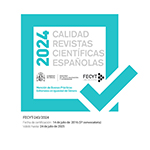Challenges of residential care for unaccompanied migrant minors: toward transnational social work
Abstract
From the turn of the century, minors who have autonomously and irregularly migrated to Europe have been cared for with residential resources from child protection services, their numbers at times exceeding the limited number of available care places. Regulating this migration has hence implicitly become a new function of social work.
Research into residential care practices in various European States and in a Spanish Autonomous Community has contributed an analysis of the tensions between migratory control and the protection of minor migrants, and of the opportunities for social intervention within the new transnational framework. This study uses interviews with experts and minors, statistical analysis of care records and observation in education and residential care centres to identify filtering practices in the allocation of residential resources to unaccompanied migrant minors as a strategy that fails to offer long-term solutions or to protect the best interest of the minors.
From the perspective of this international research experience, we conclude that the phases of the migratory cycle for unaccompanied minors coming to Europe have become a stable phenomenon, in which local administrations with responsibility for protection and transnational networks of minors and their families have adapted to each other. South European social work experiences with source countries and diversification of host care models can hence be transferred to other European States that are currently beginning to receive this migratory flow.
Downloads
Article download
License
In order to support the global exchange of knowledge, the journal Cuadernos de Trabajo Social is allowing unrestricted access to its content as from its publication in this electronic edition, and as such it is an open-access journal. The originals published in this journal are the property of the Complutense University of Madrid and any reproduction thereof in full or in part must cite the source. All content is distributed under a Creative Commons Attribution 4.0 use and distribution licence (CC BY 4.0). This circumstance must be expressly stated in these terms where necessary. You can view the summary and the complete legal text of the licence.









